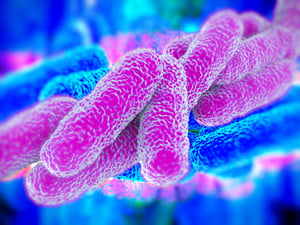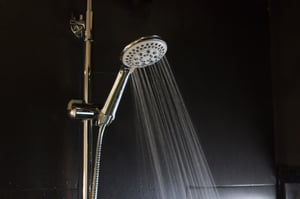The prolonged shutdown of businesses and buildings during the COVID-19 pandemic has resulted in significant reductions in normal water use for many commercial buildings, hotels, and public facilities. These reductions have increased the opportunity for Legionella growth in building water systems and created a significant risk for transmission of this waterborne bacteria to returning occupants. It's important that building owners and managers understand the risks leading to increased Legionella growth and consider them as part of an overall reopening strategy.
 Legionella is a type of Gram-negative bacteria that occurs naturally in freshwater environments. Although it is present in nature, Legionella becomes a substantial health concern when allowed to multiply in a building’s water systems. People can become exposed to Legionella when they breathe small droplets of water (aerosols) that contain the bacteria, possibly leading to Legionnaires' disease or other Legionella associated illnesses. In 2018, there were nearly 10,000 confirmed cases of Legionnaires’ disease in the United States. The majority of these recognized cases occurred in hotels, resorts, cruise ships, and healthcare facilities.
Legionella is a type of Gram-negative bacteria that occurs naturally in freshwater environments. Although it is present in nature, Legionella becomes a substantial health concern when allowed to multiply in a building’s water systems. People can become exposed to Legionella when they breathe small droplets of water (aerosols) that contain the bacteria, possibly leading to Legionnaires' disease or other Legionella associated illnesses. In 2018, there were nearly 10,000 confirmed cases of Legionnaires’ disease in the United States. The majority of these recognized cases occurred in hotels, resorts, cruise ships, and healthcare facilities.
A key step to managing the risk of Legionella-associated illness in your building is the development of a water management plan (WMP). A WMP is a building-specific risk assessment and detailed operating procedure, intended to systematically control, monitor, and prevent Legionella growth in your building’s water systems. Developing a WMP should be the combined effort of a multidisciplined program team that includes the building owner, employees and key stakeholders, and technical professionals such as engineers, Certified Industrial Hygienists, and water treatment specialists.
According to ASHRAE standard 188, the components of WMP should include:
- A building survey to identify building water systems components, develop process flow diagrams, and systematically analyze the potential for a hazardous condition;
- Identification of control locations in each system and establishment of corresponding physical or chemical parameters for control limits;
- Development of an ongoing monitoring system to verify control limit parameters and the effectiveness of program implementation; and
- Pre-planning of corrective and emergency actions to address control limit excursions or cases of Legionella associated illness.
Preventing Legionella in Domestic Water Systems
Key strategies to prevent the amplification of Legionella in domestic water systems include:
- Prevention of Stagnation: The probability of Legionella growth in a building water system increases significantly with the water’s age. Low flow conditions, stagnation, and limited water use can lead to decreases in residual disinfectant levels, increases in sedimentation and available nutrients for biofilm growth, and favorable water temperatures.
- Maintaining Water Temperature: Water temperatures within a range of approximately 68°F to 113°F will support Legionella growth. It's very important to maintain building water systems sufficiently hot or sufficiently cold to inhibit this growth. Hot water systems should be consistently maintained at or above 120°F between the water heater and points of use. This may require the use of thermostatic mixing valves or other controls at the point of use to prevent scalding. Cold water systems should be maintained below 68°F and may require regular flushing of low flow areas, recirculation, or other engineered solutions to consistently maintain safe temperatures.
- Sustained Disinfectant Levels: It's important to maintain residual disinfectant at sufficient levels throughout domestic water systems to help prevent Legionella growth. Although most water utilities treat potable water supplies to an adequate level, building owners should consult with their utilities to determine the intended type and levels of disinfectant at the point of entry into the building. Under certain conditions, building managers may need to consider supplemental disinfection to control Legionella growth throughout their distribution systems.
 Other areas for concern include points of use (e.g. faucets, shower heads, ice machines, etc.), decorative water features, pools and spas, and cooling towers which may also present significant health risks. These sources of Legionella should be included in the building’s water management plan to ensure their identification, assessment, ongoing maintenance and control.
Other areas for concern include points of use (e.g. faucets, shower heads, ice machines, etc.), decorative water features, pools and spas, and cooling towers which may also present significant health risks. These sources of Legionella should be included in the building’s water management plan to ensure their identification, assessment, ongoing maintenance and control.
If water systems have undergone prolonged interruption or decreased use, remedial treatment may be necessary to return these systems to a safe condition within control limits. Treatment options range from short-term chemical shock with high-levels of disinfectant, to thermal shock with high-temperature water, or flushing of hot and cold domestic systems. The selection of treatment options is complex and should be conducted in consultation with qualified experts to prevent harm to building occupants or damage to water system components.
In summary, water management planning is an effective strategy to reduce the risk of Legionella associated illness in commercial buildings, hotels, and public facilities. Although this strategy has been recommended by public health authorities for years, particularly in buildings occupied by high-risk populations, commercial buildings, hotels, and other public facilities may not have anticipated a need for these voluntary guidelines.
Due to the increased risk for Legionella growth during prolonged shutdowns, ongoing decreases in water usage due to remote work and occupancy restrictions, and the continued potential for further shut-downs during the COVID-19 pandemic, now may be the time to plan ahead. To learn more about how to protect your water from Legionella or to create a water management plan contact us today.
References
ASHRAE. 2018. “Legionellosis: Risk Management for Building Water Systems (ANSI/ASHRAE Standard 188).” Atlanta, GA: ASHRAE. Print. https://www.ashrae.org/technical-resources/bookstore/ansi-ashrae-standard-188-2018-legionellosis-risk-management-for-building-water-systems
ASHRAE. 2020. “Managing the Risk of Legionellosis Associated with Building Water Systems (ASHRAE Guideline 12-2020).” Atlanta, GA: ASHRAE. Print. https://www.techstreet.com/ashrae/standards/guideline-12-2020-managing-the-risk-of-legionellosis-associated-with-building-water-systems?product_id=2111422
CDC. 2020. “Guidance for Reopening Buildings After Prolonged Shutdown or Reduced Operation”. Atlanta, GA: U.S. Center for Disease Control. Retrieved from: https://www.cdc.gov/ coronavirus/2019-ncov/php/building-water-system.html
CDC. 2016. “Legionnaires’ Disease: Use water management programs in buildings to help prevent outbreaks”. Atlanta, GA: U.S. Center for Disease Control. Retrieved from: https://www.cdc.gov/ coronavirus/2019-ncov/php/building-water-system.html
CDC. 2018. “Legionella: History, Burden, and Trends”. Atlanta, GA: U.S. Center for Disease Control. Retrieved from: https://www.cdc.gov/legionella/about/history.html


